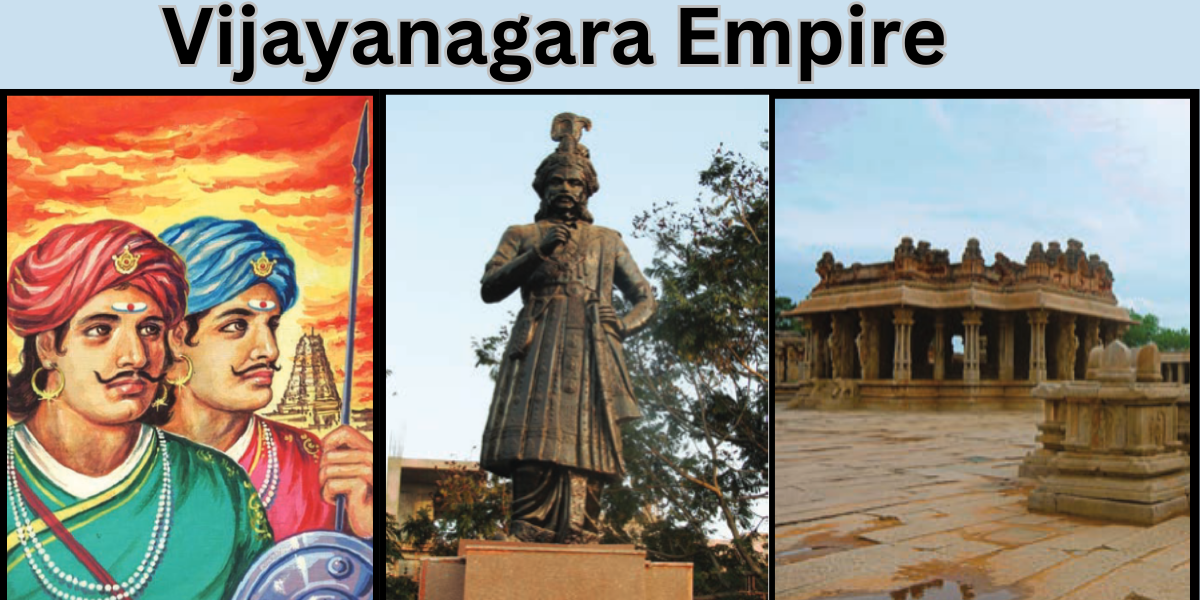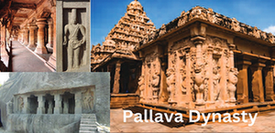Vijayanagara Empire
Origin and Expansion of Vijayanagara Empire:
Vijayanagara Empire,There are various traditions about the establishment of the Vijayanagara Empire.The Harihara and Bukka brothers, sons of Sangama who had previously served in the Hoysala rulers of Karnataka, declared independence with the blessings of Guru Vidyaranya and established a new kingdom in 1336. This happened shortly after the death of the Hoysala king Bhallala III at the hands of the Sultan of Madurai.
Initially, the capital was located near Anecondi on the north bank of the Tungabhadra River, but later it was moved to Hosapatnam, the city of Hosala on the southern bank ( near Hampi), expanded and expanded to Vijayanagara, renamed the City of Victory. The early Vijayanagara rulers followed Saivism. Their family deity was Virupaksha. Later they came under the influence of Vaishnavism. However, Lord Shiva was worshipped.The Sangama dynasty seems to have been started by Harihara . The Vijayanagara Empire witnessed the rule of four dynasties for over three hundred years:
- Sangama Dynasty (1336-1485),
- Saluva dynasty (1485-1505),
- Tuluva Dynasty (1505-1570),
- Aravidu Dynasty (1570-1650).
The history of the Vijayanagara Empire can be divided into four phases. Initially, it was one of several small principalities that emerged amid political success created by the decline of the Pandyas, Hoysalas and Kakatiyas.The five Sangama brothers, under the leadership of Harihara, seized this opportunity and consolidated and expanded their territory.In the development of the kingdom the Hoysala kingdom was incorporated in the coastal areas of Karnataka and Karnataka.The northern districts of Tamil Nadu were also brought under Vijayanagara rule, with Prince Kampana successfully defeating the Sambuvaraya chieftains and ending the Madurai Sultanate in 1370. However, the Pandya country, including Madurai, became a part of Vijayanagara only around
During Rama Raya’s reign, the combined forces of Bijapur, Ahmednagar, Golconda, and Bidar defeated him in the Battle of Talikota in 1565 , ending the Vijayanagara Empire.
Sangama Dynasty:(1334 – 1485 AD)Vijayanagara Empire
The Sangama Dynasty, the earliest rulers of the Vijayanagara Empire, ruled from 1334 to 1485 AD.The Sangama Dynasty was founded by Harihara I and Bukka.According to the history of Nunis, after conquering Gujarat, Muhammad Taklaq of Delhi captured Anegundi in 1336 and moved southwards.Hariharadeva I, also known as Deorao, secured protection from the marauding forces and established Vijayanagara on the south bank of the river .The city grew rapidly and became a haven for displaced warriors advancing Hindus, refugees and Deva Raya II, who ruled until 1446, successfully defended Vijayanagar against the combined attacks of his son Malikarjuna, the Bahmani Sultan and the Raja of Orissa.
Rulers of Sangama Dynasty:
| Ruler | Rule |
| Harihara I (Deva Raya) | 1336-1356 |
| Bukka Raya I | 1356-1377 |
| Harihara II | 1377-1404 |
| Bukka Raya II | 1404-1406 |
| Deva Raya I | 1406-1422 |
| Veera Vijaya Bukka Raya | 1422-1424 |
| Deva Raya II | 1424-1446 |
| Mallikarjuna Raya | 1446-1465 |
| Virupaksha Raya II | 1465-1485 |
End of Sangama Dynasty:
- Following the death of Deva Raya II in 1446. His eldest son, Mallikarjuna, after him, faced challenges from external threats but managed to keep the kingdom intact.Eventually, the Sangama dynasty saw its end with the rise of Narasimha Saluva.
- He deposed the last ruler, Virupaksha II, which was the “first usurpation” and transition to the Saluva dynasty.
More information for Sangama Dynasty:click
Saluva Dynasty (1485-1505):Vijayanagara Empire
Saluva Narasimha Deva Raya seized power in 1485. He removed the confluences and established the Saluva dynasty.He expanded the boundaries of the empire and strengthened its army, carving out his name as an able ruler.Art and literature flourished under his patronage, marking a golden age of cultural expression.Narasimha’s son Thimma Bhupala takes over but is soon tragically murdered.The younger brother, Narasimha Raya II, becomes king, but struggles with internal power struggles.His influential minister, Tuluva Narasa Nayake, eventually usurped the throne in 1505 and founded the Tuluva
Rulers of Saluva dynasty:
| Ruler | Rule | Notable achievements |
| Saluva Narasimha Deva Raya | 1485-1491 | – Overthrew Praudaraya and ascended the throne. – Conquered the western ports of Mangalore and Bhatkal. – Madhva saint inspired “Ramapyudayam” by supporting Sripadaraya. |
| Thimma Bhupa | 1491 | He ruled for a while after the death of his father, being tragically killed by a military commander. |
| Narasimha Raya II | 1491-1505 | – Became king after his brother’s death, but the real power was with Tuluva Narasa Nayaka. – Saw the expansion of the empire and the strengthening of defences. |
Tuluva Dynasty:(1485-1505) Vijayanagara Empire
The Tuluva dynasty had its origins in the western Tulu-speaking region.Its early ancestors were Thimmabhupathi and Devaki.Tuluva Narasa Nayaka, a mighty warrior, is credited with conquering the Gajapatis and some Muslimrulers.Krishnadevaraya, a Tulu speaker, ruled a linguistically diverse empire.The official language is Telugu.He wrote the epic poem Amuktamalyada in Telugu.The Tuluva rulers were devout Vaishnavas.Krishnadevaraya had Vyasatirtha, a Dvaita saint, as his family guru.The decline of the Tuluva dynasty marked the beginning of the decline of the Vijayanagara Empire.
Rulers of Tuluva Dynasty:
| Ruler | Rule |
| Narasimha Raya | 1491-1503 |
| Krishnadevaraya | 1509-1529 |
| Achyuta Deva Raya | 1529-1542 |
| Sadasiva Raya | 1542-1570 |
More information for Tuluva Dynasty:click
Vijayanagara–Bahmani conflict:
From the beginning, Vijayanagara was in constant conflict with the Bahmani Sultanate.The struggle for territory, tribute and control of the horse trade sparked ongoing rivalries.While the religious rivalry between the Hindu Vijayanagara and the Muslim Sultanate contributed, Vijayanagara also fought Hindu rulers such as Warangal, Kondaveedu and Orissa. Control of the horse trade passing through ports like Goa added another dimension to the conflict. The Krishna River roughly divided parts of Vijayanagara and the Bahmani Sultanate.In coastal Andhra, the Gajapati kingdom of Orissa engaged in a power struggle.Vijayanagara faced challenges until the time of Deva Raya II (1422–46), who successfully expanded his kingdom against the Orissa army .However, after Deva Raya II, internal conflicts and incompetent successors weakened Vijayanagara.
Battle of Talaikota:
Succession conflicts led to internal conflicts. Ramaraya tried to dominate.The Battle of Talikota in 1565 was a turning point when the victorious Bahmani forces sacked Vijayanagar as a result of the defeat of Rama Raya. It marks the downfall of the Vijayanagara Empire.The Aravidu dynasty, started by Tirumala in 1570, ruled the severed kingdom for two generations .
Vijayanagara Empire Administration:
The king had ultimate authority and served as the supreme commander of the army .The administrative divisions were mandalams, nadus, sthalas and, finally, villages.The chief minister headed the hierarchy of officers, including the mahapradhani, the commander (commander), the vasal (the guard of the palace), the rayasam (secretary/accountant), the adaippam (personal assistant) and the garia-karta (administrative agents). A group of 12 officials, called Iyengars, looked after village affairs.This territory was organized into administrative divisions called Each was under a governor or prime minister.Under the Naicker system, the highest officers of the army were called Nayaks/Palayakkarars and were given land in return for their services. They named it Amaram.The Tuluva dynasty witnessed the decline of kingdoms in favour of the Nayaka system.
Nayak System :
The Nayak system, founded in 1500, avoided allocating revenue-generating territories to military leaders (Nayaks) in return for their services.The system gained prominence under Krishnadevaraya, and in the sixteenth century, the Nayaks became somewhat independent of the Vijayanagara The Nayak chiefs controlled production, encouraged handicraft production , and established powerful kingdoms after the Battle of Talikota.
Society and Economy:
A series of wars in the Bahmani and Vijayanagara territories resulted in widespread suffering and displacement.The ruling class enjoyed prosperity. At the same time, the masses faced poverty. This led to revolts against unfair tax demands.Handicraft production, especially weaving, flourished during the Vijayanagara period.This marked a shift towards a more commercial economy.The sixteenth century saw significant advances in non-agricultural The economy became more commercial and the circulation of currency money increased. The prosperity of the rulers contrasted sharply with the poverty of the common people.
Fall of Vijayanagara Empire:
With the decline of the Vijayanagara Empire, the sultans of Golconda and Ahmednagar, who were affected by the activities of Rama Raya, joined the alliance against Vijayanagara. By 1564, four of the five sultans were marching towards Vijayanagara, leading to the devastating Battle of Talaikota.The result was a crushing defeat for Vijayanagara, resulting in the plundering and destruction of much of the city.During this hectic period, internal conflicts arose after the prosperous reign of Krishnadevaraya .Controversial dynasties and weak leadership have fostered corruption and incompetence within the administration.The Nayaks, granted autonomy by Krishnadevaraya, grew increasingly independent and ambitious, sparking internal power struggles.
These challenges were reinforced by the Deccan sultanates, especially Bijapur and Golconda, and posed a constant threat to Vijayanagara’s borders.The empire was riddled with economic difficulties, worsened by constant warfare and the decline of trade routes. This vulnerability exposed Vijayanagara to external attacks.The Vijayanagara army suffered considerable losses and the city itself fell prey to deposition and plunder.Rama Raya met his demise, captured and killed during the turmoil, while his brother Tirumala Raja and part of the royal treasury managed to escape




Pingback: Sangama Dynasty
Pingback: Tuluva Dynasty
Pingback: Saluva Dynasty
Pingback: Bahmani Kingdom